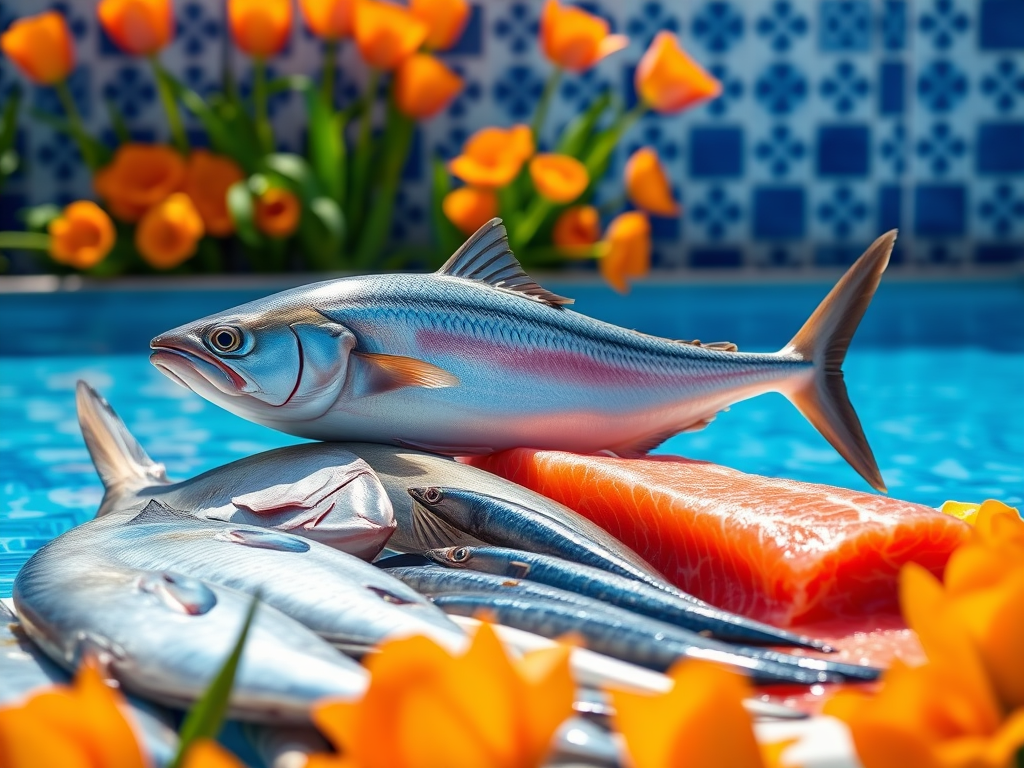
Summary: eating fish is healthy. However, due to an increasing number of foreign substances like mercury, one has to limit fish consumption. When I realized this I cut down my fish consumption by half.
Fish: great, but from now on a cautious “yes”
At home, we used to eat fish almost every day over the past five years. The health benefits of fish are well known. However, we neglected important dangers. Issues like PCBs, nano plastics, and mercury are truly concerning. Other heavy metals and antibiotics in farmed fish also worry me as an enthusiastic fish consumer.
So I dived into this topic to see whether we could continue eating fish every day. The short and sad conclusion is “no”. It was already “no” to farmed fish. We should also avoid fish that is most likely to have high levels of mercury. PCBs and nano plastics are also concerns. This is all easier said than done. When buying fish, the amounts of mercury and other harmful components are not labeled. They probably never will be, as they are difficult to measure. With mercury it is more or less known which fish is mercury heavy and which not. When it comes to farmed fish, you can find out what is wrong. But what about other heavy metals? PCBs? Nano plastics?
2. Why take the risk?
To those who say that the Japanese eat fish almost daily, I admit I have no answer. They argue that Japanese are among the longest-living people in the world. Food and health are complex issues, as I have come to realize over the past few years.
Not everything is scientifically proven. However, there are many indications of potential negative effects from eating fish more than a few times per week. So, why take the risk? Especially when you can maintain a very balanced diet without consuming fish daily.
3. Do you need fish for your necessary protein intake?
We humans have several other protein sources legumes, nuts, eggs, light French quark, soya milk, seeds, and plant-based proteins. In another blog I wrote that people tend to undereat protein, something that is very harmful especially if one ages. Eating fish helps. Chicken also helps. For us, fish is “just” one of the protein sources. It is an important contributor to a tasty meal.
4. Just to repeat the benefits of fish. It is an excellent source of high-quality protein. It also provides omega-3 fatty acids, especially in fatty fish like herring and salmon. Additionally, it contains vitamins such as vitamin D and B2. It also has minerals like calcium, phosphorus, iron, zinc, iodine, magnesium, and potassium. Omega-3 fatty acids are beneficial for heart health. They may lower the risk of heart attack and stroke. He/she who eats fatty fish a few times per week really should not take Omega-3 supplements.
One portion of fatty fish can provide a significant amount of EPA and DHA. Fish like salmon, mackerel, sardines, or herring can offer approximately 250 to 500 mg of these nutrients. The exact amount depends on the type and size of the fish. This amount is typically recommended for maintaining overall heart health. Most sources I read talk about two portions per week of fatty fish.
5. Lean (white) fish typically contains much lower levels of omega-3 fatty acids. This is in comparison to fatty fish such as salmon, mackerel, sardines, and herring. Omega-3 fatty acids are primarily found in the fats of fish. White fish are usually much leaner, so they provide fewer omega-3s. They remain a healthy option as they provide high-quality protein, vitamins, and minerals.
Some examples of lean fish include Cod, Haddock, Pollock, Hake, Flounder, and Sole. Tilapia (but see my critical remarks on farmed fish), Whiting, Bass, and Shrimps are also lean fish. The following white fish are, unfortunately high on mercury: Sea bream, Sea bass and Turbot.
All international health agencies recommend two portions of fish, with a maximum of three (150 grams). At least one portion should be fatty fish, like herring or salmon. The other can be white fish like cod. White fish lack however the all-important omega-3 with EPA (“eicosapentaenoic acid”) and DHA (“docosahexaenoic acid”),
6. Mercury: important to realize the potential impact on your health
In this blog, I delve a bit deeper into one of the dangers of eating fish: mercury. It is a hazardous heavy metal that we primarily ingest through eating fish. Once it reaches the brain, it can remain there for decades, accumulating and impacting the nervous system. Serious stuff. Other heavy metals, PCBs, and nano plastics might be just as dangerous. These topics will be discussed in other blogs.
(Note: PCBs, or Polychlorinated Biphenyls, are a group of man-made organic chemicals consisting of carbon, hydrogen, and chlorine atoms. They were widely used in various industrial and commercial applications. PCBs have been found to have significant environmental and health impacts; studies are ongoing.)
Some things are recent developments, like nano plastics. We know it is a developing health scare worldwide. Its consequences are not yet known. I cannot imagine that it is good for your body. Who wasn’t alarmed to read that the average adult brain now contains a spoonful of nano plastics? Also a topic for a future blog.
7. From mercury to methylmercury: a technical explanation
Mercury is a global pollutant. It enters water bodies for 1/3 through atmospheric deposition. This deposition results from natural events like volcanic eruptions. For 2/3, mercury enters through human activities such as coal burning and industrial processes.
The legacy of human use of mercury has caused mercury to be released into the environment in enormous quantities. These releases amount to hundreds of thousands of tons. The levels of mercury in the atmosphere at the moment are up to 500 % above natural levels. In the oceans, the concentrations of mercury are about 200 % above natural levels.
Mercury can undergo chemical transformations once it is deposited to the landscape. Of greatest concern to fish, wildlife, and humans is mercury’s conversion to methylmercury. This conversion is most common in wetlands that are periodically flooded, where the bacteria that facilitate the process are abundant.
Fish absorb methylmercury from the water they live in and from the organisms they eat. Methylmercury is a highly toxic form that accumulates in fish, especially in long-lived and predatory species.
8, Bioconcentration (or biomagnification) refers to the process by which mercury concentrations increase as they move up the food chain. This process results in higher concentrations in higher-level predators such as fish, birds, minks, and otters. Through bioconcentration, mercury levels can increase by 100 to 1,000 times or more. As a result, even low concentrations of mercury in water can contaminate an entire food chain. This contamination makes fish unsafe for human consumption.
Mercury usage and emissions have been reduced in regions such as Europe and North America. Despite this, environmental levels of mercury are likely to remain high for a long time. This persistence is due to mercury’s long lifetime in the environment and increasing emissions in other parts of the world. These emissions can travel long distances. In fact, about half of the mercury deposited in Europe comes from outside the continent.
The biological half-life of mercury is estimated to be approximately 30 to 60 days in the body. The half-life of mercury in the brain is not entirely clear. However, it is estimated to be as long as approximately 20 years.
9. Fish with high or low mercury level
Mercury levels differ from one species of fish to the next. This is due to factors such as the type of fish, size, location, habitat, diet and age.
Fish that are predatory (eat other fish) are large and at the top of the food chain, and so tend to contain more mercury. This includes tuna and swordfish. Try to avoid them and go for wild salmon, herring, sardines etc.
10. Potential Health impact is serious
The health impacts of mercury are dose-related, but the main concern is its impact on fetuses and young children. Mercury exposure can occur in the womb due to a mother’s consumption of seafood, which can have significant and lifelong effects on a baby’s developing brain and nervous system. This exposure can affect memory, language, attention, and other skills. In Europe alone, it is estimated that more than 1.8 million children are born each year with mercury levels above recommended safe limits.
In adults, chronic mercury exposure can lead to neurological and developmental issues. Symptoms of mercury poisoning can include tremors, memory problems, and cognitive deficits. In severe cases, it can affect kidney function and the respiratory system. Mercury exposure can also potentially impact cardiovascular and immune health in adults.
11. Possible symptoms of methylmercury poisoning may include
Loss of peripheral vision; pins and needles” feelings, usually in the hands, feet, and around the mouth; lack of coordination of movements; impairment of speech, hearing, walking; and/or muscle weakness.
12. Testing
It is possible to measure the levels of mercury in your body through blood tests, urine tests, and hair analysis. The last method is particularly interesting. Measuring mercury levels in hair can provide an estimate of long-term exposure to methylmercury. Hair accumulates mercury steadily as it grows. This reflects exposure over months rather than days. This is useful for assessing chronic exposure.
13. My Experience
For years, we enjoyed our daily fish meals. However, preparing this blog made me realize my naivety during all those years. Yes, fish is healthy. However, it can also carry many harmful substances. These include heavy metals, PCBs, nano plastics, and antibiotics.
We ate tinned sardines and mackerel. We also had deep-frozen cod from the North Atlantic. Of course, we enjoyed sustainably fished fresh Dutch herring and the occasional wild salmon.
It proved to be almost impossible to get hard data on which fish carries which substances. It is probably too complex; I realize this. But, I have read too much worrying news from reliable sources to continue with my current level of fish consumption.
So we decided to cut down on fish. We enjoy Dutch herring once or twice a week. We have wild salmon once a week. Both are oily fish providing omega-3 fatty acids.
Additionally, I will do a hair analysis to check if mercury has accumulated in my body.
Time for dinner, but no fish tonight :). Enjoy a long and healthy life,
Robert, your health friend




